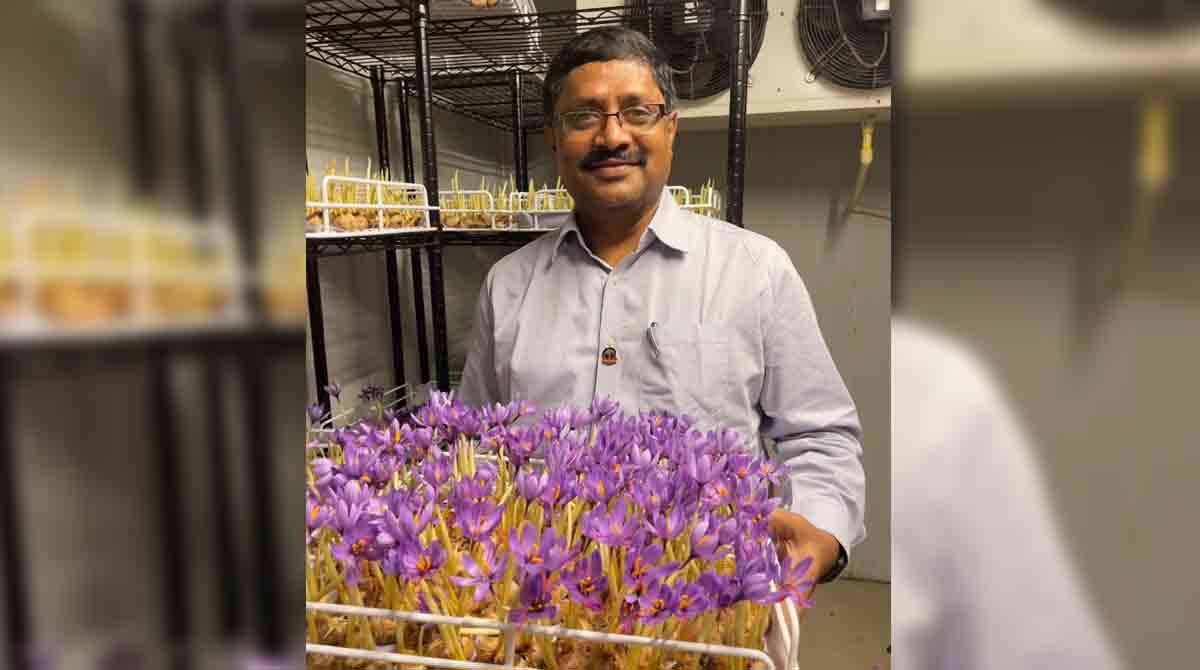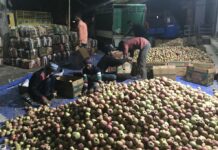With massive import dependence for the world’s most expensive spice, Saffron, the government and several fortune hunters are literally in a race to cultivate the spice in Northeast, West Bengal, Maharashtra, Kerala, and Madhya Pradesh using all the available technologies, reports Masood Hussain
Amidst a demand-supply mismatch in Saffron, the world’s most expensive spice, valued nearly three times the weight of silver per kilogram, an increasing number of enthusiasts across India are venturing beyond Kashmir for cultivation. While innovative growers are embracing outdoor methods, utilizing poly-houses, ambitious entrepreneurs are pioneering cultivation in controlled atmosphere laboratories, diversifying saffron production beyond traditional boundaries.
At various locations, the Krishi Vigyan Kendra (KVK) plays a pivotal role in supporting these groundbreaking initiatives, fostering a shift toward more lucrative cash crop cultivations. The cultivation of saffron has evolved globally, with growers utilising a combination of indoor and outdoor fields.
In Kerala
The Perumala region in Kerala’s Kanthalloor belt is locally known as the “Kashmir of Kerala’ as it lives on an elevation of around 5000 ft and is home to various fruit and vegetable species that otherwise grow in cold climate conditions.
There, KVK projects under the guidance of the Indian Council for Agriculture Research (ICAR), a couple of farmers are being helped to grow saffron at Vattavada, Kanthalloor and Vagamon. The experimentation started in 2022 when they were given the Saffron bulbs that were flown from Kashmir.
Ramamoorthy, one of the farmers said his plantation was in half bloom in 2022 but the heavy downpour destroyed it. This year, he cultivated saffron in open spaces as well as in a playhouse. The bloom was reported in both plantations, 50 days apart. Once the harvest is complete, the officials and the farmers said they will check the yield and explore the possibility of taking it further.
In West Bengal
The University of North Bengal (NBU)’s Kopham Department (Centre of Floriculture and Agribusiness Management) is also experimenting with Saffron cultivation and the initial success has led to the extension of the crop in some hill areas including Kalimpong. Reports appearing in the media suggest that NBU was the first laboratory in India to experiment with saffron cultivation. Later 80 seed bulbs sourced from Kashmir were cultivated in areas like Toagaon, Upper Chacha, and Kalimpong. It is now being projected as a way out to manage the surging unemployment with youth being encouraged to grow the spice at home.
NBU laboratory is offering three methods for growing the costly crop – outdoor poly-house, hydroponics and open outdoor. At Kalimpong’s hydroponics facility, media reports suggest 80 seedlings were planted on October 28, and within 15 days, flowering was reported.

In Madhya Pradesh
Since 2016, a local environmentalist Dr Shankar Garg, who has a lot of knowledge about agriculture, has created Kesar Parvat on the outskirts of Indore. He has been growing different fruit, tree and vegetable species in his 22-acre forest, which is gradually emerging as a tourist attraction too.
For him, growing Saffron has been a challenge. Finally, he got in touch with a Kashmiri farmer who drove to Indore with 25 saffron corms and taught him the fine skills required for growing the spice in a climate where scorching heat devours most of the summer. It did not fail but the bloom was very restricted. This year, the harvest has been reported to be better with around 200 flowers being harvested. To ensure that this symbolic harvest becomes possible, the promoter had to maintain a temperature of 18 degrees celsius using air conditioning and ice-cold water.
In Gujarat
In December 2021, Sahil Ninama and Mayank Dabhi floated a startup at Gandhinagar, Aeroponics Saffron Farming aimed at using the most modern technology in growing the spice. Aeroponics is the technology in which plant life is cultivated without soil and water using mist as the medium to feed the plant for growth. This technology helps the grower to have four harvests in a year in comparison to the natural cultivation that fetches a single crop.
In order to experiment with the cultivation, the startup got some space at the Swarrnim Incubation Center of Swarrnim Startup and Innovation University in early 2023. This fall, the start-up harvested the first crop in its 10 x 10 ft space. The promoter has said they have improvised on the saffron production process and reduced it by one-fourth. So far, they have established that from 100 kgs of corms, they can produce slightly more than half a kilogram of saffron. The plan is to take the technology to wastelands where the spice can be produced in controlled spaces.
The startup has received Rs 1.46 lakh as a grant from the Gujarat government and the University.
In Maharashtra
In early 2022, Shailesh Modak, a Nashik software engineer, gave up his job of 13 years and launched a start-up, 365Dfarms. He got a shipping container, parked it at Warje in the outskirts of Pune and started experimenting with Saffron cultivation.
Modak used a different technology, hydroponics, a technique using a water-based nutrient solution rather than soil. It can include an aggregate substrate, or growing media, such as vermiculite, or coconut coir. In the very first year, reports appearing in media suggest, he harvested 875 grams of saffron from a 160 sq ft area in controlled conditions. So far, he has invested nearly Rs 10 lakh.
At the very start, Modak told reporters that he understood the system of growing the spice and managed the corms from Kashmir, literally the mother of Saffron cultivation in the Indian subcontinent.
In North East
These experiments came to media light in recent years but there are various other places where the farmers, with or without the help of the government, are making efforts to grow the plant. Last year, the Government of Sikkim signed an agreement with the Jammu and Kashmir government to help in Saffron cultivation in certain areas of Sikkim.
In 2020, the North East Centre for Technology Application and Reach (NECTAR) took Kashmir saffron seeds and planted it the Yangyang belt in south Sikkim and parts of Arunachal Pradesh, Mizoram and Meghalaya. Media reports suggest that as many as 17 sites – Chug, Darjeeling, Shergaon and Walong (Arunachal Pradesh), Laitkor, Mairang, Nongshilliang, Thangsning, Umpling and Upper Shillong (Meghalaya), Ailwang, Lunglei and North Vanlaiphai (Mizoram) and Lachung, Phengla, Sajong and Yoksum (Sikkim) were identified after meticulously studying the soil reports and the climatic conditions of Pampore, the main Saffron bowl.
In October 2022, 225 kg of saffron corms were flown to the northeast and distributed among the states as an expert from Pampore explained the cultivation processes. Last year, Tawang cultivation resulted in a good crop but snowfall destroyed it. Interestingly it was Yoksum in Sikkim where all the corms survived. In two years, nearly a thousand off farmers have associated themselves with the project and the idea is to bring nearly 500 acres of land under saffron cultivation in the region. The future project includes setting up a tissue culture lab for in-vitro corm generation for a continuous corm supply and setting up dryers in a common facility centre for farmers.
Corm Demand
Beyond all these places, efforts are underway to experiment with the costly spice cultivation. This might be the reason why the corms are in demand. On August 29, 2023, 300 kilograms of saffron bulbs were seized at Air Cargo Srinagar. The consignment was recovered in a joint raid by the Director of Agriculture, Assistant Director Law Enforcement Srinagar and Law Enforcement Inspector Srinagar from the Enforcement Wing centre, besides the Excise Department and Central Enforcement, Srinagar.
Right now, the yield from all these places is being tested for its ingredients. Saffron has 150 bioactive compounds including crocin, picrocrocin, safranal, kaempferol and quercetin. Three major compounds Safranal, crocin and procrocin basically decide the quality of the produce. Crocin content in Iranian saffron is 6.72 per cent but in Kashmir, it is 8.72 per cent. Iran produces almost 88 per cent of the world’s estimated 300 metric tons of saffron every year but it sells nearly half the rate of Kashmiri produce.
Saffron corms require a 45-day chill during winter and adequate rain or irrigation in August and October. While most of these places manage the soil, the exact climatic conditions are challenging.
India which requires almost one-third of the global supply of saffron for its wellness, healthcare, pharmaceuticals and religious requirements is keen to improve domestic production. There is an emphasis on improving yield in Kashmir saffron fields as well.
In Kashmir
Even though Saffron production fluctuates with weather and other allied issues, the emphasis remains on improving the yield. With Pampore as the historic centre for saffron cultivation, the spice is cultivated in a few small villages in upper Srinagar and a vast belt in Budgam. Outside Kashmir, it has been cultivated in Kishtwar for ages in almost 100 villages including Thakraie, Kuchhal, Kuchhan, Bunjwah, Inderwal (Chatru), Palmar, Trigam, Poochal, Dool, Padyarna, Nagseni, Paddar (Ligri and Tata Pani) and some villages of Drabshala and Dachhan blocks on more than 200 hectors of land. However, the yield is not very impressive. The same corms being used in Kishtwar when planted in Kashmir perform better. Off late, some experimental corm plantations have been made in upper Udhampur and Reasi areas where the land quality and climatic conditions resemble Kashmir.
CSIR’s Indian Institute of Integrated Medicine (IIIM) has bagged a DBT project to explore the possibility of Saffron cultivation in almost all districts of Kashmir. It has been there for the last few years. What is interesting is that the trials in all the districts have shown very positive results. “It grows everywhere in Kashmir as long as soil and climate suits the crop,” one official associated with the project said. “The corm faces many challenges and one of them is rot. We have found a microbe that can naturally help the corm from an early decay but the work is still in progress.”
The SKUAST-K’s Advance Research Station For Saffron and Seed Spices (ARSSSS) which has done all the basic work on Saffron is experimenting with the indoor farming of Saffron. In the last few years, it helped a few farmers in north and south Kashmir in growing the spice in trays within the rooms having proper temperature, humidity and nutrient composition. The yield in vertical saffron farming has been better.
Some people who know the plant sciences better are also engaged in their own experiments. In Kulgam, Zahoor Ahmad Reshi, cultivated saffron on his rooftop in eleven lay-flats on a 100 sq ft area. He also used the aeroponics technology. Many families in Paris are also using the rooftop farming of Saffron and it is a huge business.
Challenges Remain
Despite all this, the research community will have to help the farming community in managing some serious challenges including making the bulb drought-resistant and helping it protect itself from pests. Authorities have already invested Rs 412 crore under the Saffron Mission to help the farmers revive spice cultivation, created Spice Park, ensured the spice gets GI tag and managed drip irrigation of saffron fields partly. This has lured lot many farmers from undoing the arbitrary conversion of land use but the drip irrigation set-up is yet to work optimally.
Jammu and Kashmir cultivates Saffron on nearly 5700 hectares of which nearly 3300 hectares are in Kashmir. The yield however varies from place to place.















